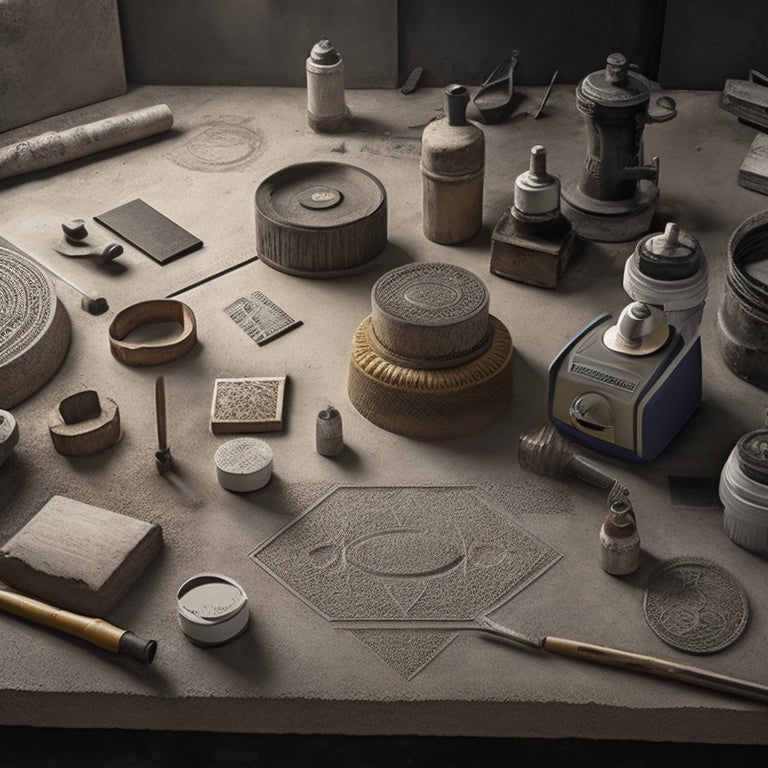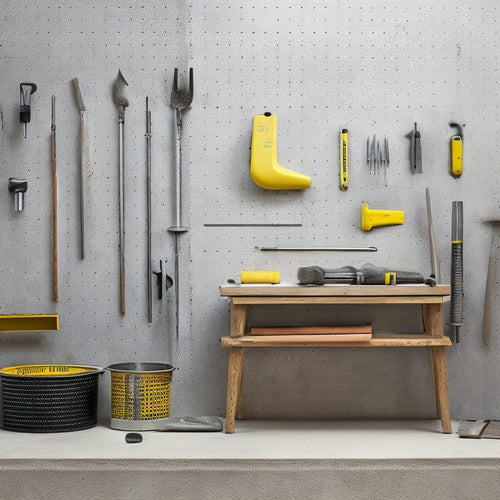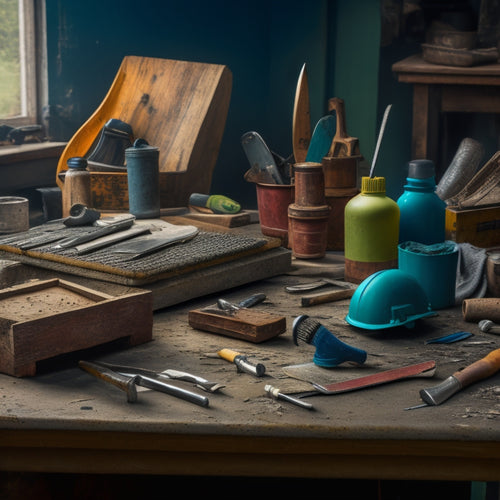
7 Essential Tips for Buying Concrete Engraving Tools
Share
When buying concrete engraving tools, you'll want to determine your project's specific needs, considering factors like project type, material compatibility, and level of detail. Set a realistic budget range, prioritizing must-have tools and factoring in maintenance and replacement costs. Choose the right engraving method, evaluating options like stencil, freehand, or pattern engraving. Assess tool durability, checking for high-quality materials, wear resistance, and construction quality. Research online reviews, inspect tool quality before buying, and select the right tool size for your project. By following these essential tips, you'll be well-equipped to make informed purchasing decisions that yield professional-looking results, and discover even more insights to take your concrete engraving skills to the next level.
Key Takeaways
• Determine your engraving needs, including project type, material compatibility, and level of detail, to choose the right tools for your project.
• Set a realistic budget range, prioritizing essential tools and considering additional expenses, to ensure effective project completion.
• Select the right engraving method, considering technique, tool selection, and method suitability, to achieve desired visual effects and intricacy.
• Assess tool durability factors, including material composition, wear resistance, and construction quality, to ensure long-term performance and minimize wear and tear.
• Check online reviews and ratings, evaluating user insights, performance, and credibility, to make an informed purchasing decision.
Determine Your Engraving Needs
Determine the type of concrete engraving project you want to undertake, as this will dictate the specific tools and equipment you'll need to achieve the desired results. Are you looking to create intricate designs, patterns, or textures on a concrete surface? Or do you want to add a personal touch to your patio, walkway, or driveway? Identifying your project's requirements will help you choose the right engraving style and technique.
Evaluate the material compatibility of your concrete surface. Is it new, old, or stamped? Different surfaces require specific tools and techniques. For instance, new concrete may require more aggressive tools, while older concrete may need gentler approaches.
You'll also need to assess the level of detail and precision required for your project. Do you need to create fine lines, intricate patterns, or bold designs? By understanding your project's unique needs, you'll be able to select the right tools and equipment to achieve professional-looking results.
Set a Realistic Budget Range
As you prepare to invest in concrete engraving tools, it's crucial to set a realistic budget range to guarantee you get the right equipment for your needs.
You'll need to determine how much you're willing to spend, set a ceiling, and prioritize the essentials to make the most of your budget.
Determine Your Needs
You'll need to assess your concrete engraving goals and the scope of your projects to establish a realistic budget range for the tools you'll require. This involves considering the type of engraving styles you'll be working with, the frequency of use, and the maintenance tips you'll need to keep your tools in top condition.
To help you determine your needs, ask yourself the following questions:
| Considerations | Questions to Ask |
|---|---|
| Project scope | Will you be working on small, intricate designs or large-scale projects? |
| Frequency of use | How often will you be using your concrete engraving tools? |
| Maintenance | Are you willing and able to perform regular maintenance tasks, such as cleaning and sharpening? |
| Specialized tools | Do you need specialized tools, such as diamond-coated bits or carbide-tipped engravers, for specific engraving styles? |
Set a Ceiling
Establishing a realistic budget range for your concrete engraving tools is essential to confirm you invest in the right equipment for your projects without breaking the bank.
You'll need to reflect on the material options you're working with, as well as the project longevity, to determine how much you're willing to spend. For instance, if you're working on a large-scale project that requires high-quality, long-lasting tools, you may need to invest in more expensive equipment. On the other hand, if you're working on smaller projects or experimenting with different techniques, you may be able to get away with more affordable options.
When setting your budget, reflect on the cost of the tools themselves, as well as any additional expenses such as maintenance, replacement parts, and training.
You'll also want to think about the potential return on investment – will the tools you choose help you complete projects more efficiently, or produce higher-quality results that will attract more clients?
Prioritize Essentials
To prioritize essentials, start by identifying the must-have tools that will allow you to complete your concrete engraving projects efficiently and effectively, and allocate your budget accordingly.
You'll need to distinguish between essential accessories and nice-to-haves. Focus on the core tools that will get the job done, such as engraving bits, grinding wheels, and polishing pads. These are the tools that will help you achieve the desired finish and quality.
Once you've identified the essential tools, consider maintenance tips to extend their lifespan. Regular cleaning, lubrication, and storage will help prevent wear and tear, reducing the need for frequent replacements.
Allocate a portion of your budget for maintenance and repairs, as this will save you money in the long run.
Choose the Right Engraving Method
When selecting concrete engraving tools, you'll need to determine the best engraving method for your project.
You'll have to evaluate various techniques, such as stencil, freehand, and pattern engraving, each requiring specific tools and expertise.
Engraving Technique Options
You'll need to select an engraving technique that suits your project's specific requirements, as different methods yield distinct visual effects and levels of intricacy. Depending on the desired outcome, you may opt for techniques like stippling, which creates detailed, high-contrast designs, or freehand engraving, which allows for more expressive, artistic styles.
Other popular engraving techniques include carving, which involves removing concrete to create a three-dimensional design, and stenciling, which involves applying a pattern or design to the concrete surface using a template. Each technique requires a specific set of tools and skills, so it's crucial to choose the right method for your project.
For instance, if you want to create intricate, detailed designs, you may need to use specialized engraving tools, such as diamond-tipped bits or carbide-tipped engravers. On the other hand, if you're looking for a more rustic, textured look, you may opt for a more manual approach, such as using a hammer and chisel.
Tool Selection Criteria
Selecting the appropriate engraving tool hinges on a thorough understanding of the project's requirements, including the type of concrete, desired level of intricacy, and visual effect. You need to evaluate the specific demands of your project to choose the right tool for the job.
When choosing an engraving tool, you'll want to assess the following key factors:
-
Concrete type: Will you be working with freshly poured, cured, or stained concrete? Different tools are better suited for different types of concrete.
-
Engraving materials: Will you be using diamonds, carbides, or other materials to achieve the desired effect? Each material has its strengths and weaknesses.
-
Tool brands: Research reputable brands known for producing high-quality engraving tools, such as Bosch, DeWalt, or Hitachi.
Method Suitability Assessment
How do you determine the most suitable engraving method for your concrete project, considering factors like surface preparation, design complexity, and desired finish quality? To guarantee a successful outcome, you'll need to conduct a thorough method evaluation.
Start by evaluating the surface preparation requirements for each potential method. Will you need to apply a bonding agent or sealant?
Next, analyze the design complexity of your project. Does it involve intricate patterns or simple text? Different methods excel in different areas, so it's essential to choose the one that best suits your design needs.
Finally, consider the desired finish quality. Are you looking for a high-gloss finish or a more subtle, matte look? By comparing techniques and analyzing their strengths and weaknesses, you can make an informed decision.
Technique comparison is key in this process, as it allows you to identify the most suitable method for your specific project requirements. By taking the time to evaluate your options, you can guarantee a professional-looking finish and a successful concrete engraving project.
Consider Tool Durability Factors
When evaluating concrete engraving tools, an essential aspect to examine is the durability of the tool's components, including the engraving bits, shafts, and handles, as they directly impact the tool's lifespan and performance. You want to verify that the tools can withstand the rigors of regular use and harsh environments.
To assess durability, consider the following key factors:
-
Material composition: Look for tools made from high-quality materials that can resist corrosion and wear. For example, engraving bits with tungsten carbide tips are more durable than those with steel or copper.
-
Wear resistance: Check if the tools have a wear-resistant coating or surface treatment to minimize wear and tear.
-
Construction quality: Inspect the tool's build quality, including the handle's ergonomics and the shaft's rigidity, to verify it can withstand heavy use.
Check Reviews and Ratings Online
What do other users have to say about the concrete engraving tools you're considering, and can their experiences inform your purchasing decision?
You'll want to scour online review platforms, forums, and social media to gather valuable insights from users who've hands-on experience with the tools. Pay attention to user reviews, ratings, and product comparisons to get a well-rounded view of each tool's performance, durability, and ease of use.
Look for specific details about the tool's ability to engrave concrete effectively, its versatility, and any potential drawbacks.
When analyzing reviews, consider the credibility of the source and the reviewer's level of expertise. Be cautious of biased or fake reviews, and instead, focus on genuine feedback from users who've invested time and effort into testing the tools.
By doing so, you'll be able to identify patterns, both positive and negative, that can notably influence your purchasing decision.
Select the Right Tool Size
You'll need to choose a concrete engraving tool that's proportionate to the scale and intricacy of your projects, as a tool that's too small or too large can hinder your ability to achieve precise, high-quality engravings.
When selecting the right tool size, consider the following factors:
-
Project scope: Ascertain the tool is suitable for the size of your project. A larger tool may be needed for bigger projects, while smaller tools are better suited for detailed work.
-
Tool ergonomics: Choose a tool that fits comfortably in your hand, allowing for ideal control and precision. A tool that's too heavy or bulky can lead to fatigue and decreased accuracy.
-
Size compatibility: Verify that the tool is compatible with your existing equipment and accessories. This will ensure seamless integration and minimize potential workflow disruptions.
Inspect Tool Quality Before Buying
Before making a purchase, scrutinize the concrete engraving tool's quality by examining its construction, material, and performance features to guarantee it meets your project's demands and withstands repeated use. You want a tool that can handle the rigors of concrete engraving and produce consistent results.
When evaluating tool quality, consider the following key factors:
| Factor | What to Look For |
|---|---|
| Tool Materials | Durable materials like tungsten carbide or diamond-coated tips for ideal performance and longevity |
| Brand Reputation | Research the manufacturer's reputation for producing high-quality tools and providing reliable customer support |
| Performance Features | Adjustable handles, ergonomic design, and precision-engraved tips for comfort and accuracy |
| Construction Quality | Solid build, robust connections, and minimal vibration for reduced fatigue and improved control |
Frequently Asked Questions
What Safety Precautions Should I Take When Engraving Concrete?
When engraving concrete, you'll want to prioritize safety above all.
First, develop a controlled engraving technique to minimize dust and debris.
Wear personal protective equipment (PPE) like safety glasses, gloves, and a dust mask to shield yourself from harmful particles.
Additionally, guarantee good ventilation and avoid breathing in concrete dust.
Finally, keep your workspace clean and organized to prevent tripping hazards.
Can I Engrave Concrete With a Regular Drill or Hammer?
You're barking up the wrong tree if you think a regular drill or hammer will cut it for concrete engraving.
The truth is, you'll need specialized drill types, like rotary hammers or impact drivers, designed for the task.
These tools provide the necessary torque and speed for various engraving techniques, ensuring a professional finish.
Don't risk damaging your equipment or the concrete – invest in the right gear for the job.
How Do I Maintain and Clean My Concrete Engraving Tools?
You'll want to extend the life of your concrete engraving tools by mastering proper maintenance techniques.
Regularly clean your tools with a wire brush to remove concrete residue and debris.
Apply a rust-inhibiting lubricant to metal components to prevent corrosion.
Store your tools in a dry, cool environment to prevent moisture damage.
Are Concrete Engraving Tools Suitable for Engraving Other Materials?
You're wondering if your concrete engraving tools can be used on alternative materials. The answer is, it depends.
While they can be adapted for engraving techniques on materials like wood, metal, or stone, you'll need to take into account the tool's specifications and the material's hardness.
Don't assume a one-size-fits-all approach; research the best engraving techniques and tool modifications required for each material to achieve the best results.
Can I Rent Concrete Engraving Tools Instead of Buying Them?
When considering concrete engraving tools, you're likely weighing the cost of ownership against rental options.
You'll want to do a cost comparison to determine which approach makes sense for your specific needs.
If you only need the tools for a one-time project, renting might be the way to go.
However, if you plan on using them frequently, buying could be more cost-effective in the long run.
Conclusion
You've finally made it to the end of this concrete engraving tool buying guide, and you're probably thinking, 'I'm an expert now, I can engrave the Taj Mahal!'
Not quite. Remember, buying the right tools is just the first step. The real challenge begins when you start engraving.
But, with these 7 essential tips, you'll at least have a fighting chance of creating something that doesn't resemble a kindergartener's art project.
Happy engraving!
Related Posts
-

10 Best Tools for Sealed Concrete Flooring on Budget
When starting on a sealed concrete flooring project on a budget, you'll need to prioritize essential tools without sa...
-

10 Must-Have Tools for Concrete Repair Organization
You'll need a solid organization system to keep your concrete repair tools and materials within easy reach, protected...
-

Must-Have Handheld Tools for Concrete Repair
When tackling a concrete repair project, it is crucial to have the right handheld tools to achieve a professional fin...


